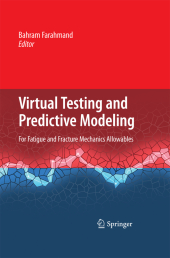 Neuerscheinungen 2014Stand: 2020-02-01 |
Schnellsuche
ISBN/Stichwort/Autor
|
Herderstraße 10
10625 Berlin
Tel.: 030 315 714 16
Fax 030 315 714 14
info@buchspektrum.de |

Bahram Farahmand
Virtual Testing and Predictive Modeling
For Fatigue and Fracture Mechanics Allowables
Herausgegeben von Farahmand, Bahram
2009. 2014. xxiii, 407 S. 35 Tabellen. 235 mm
Verlag/Jahr: SPRINGER, BERLIN; SPRINGER US; SPRINGER 2014
ISBN: 1-489-98370-8 (1489983708)
Neue ISBN: 978-1-489-98370-1 (9781489983701)
Preis und Lieferzeit: Bitte klicken
This overview of cost- and time-efficient methods to obtain fatigue and fracture data introduces two virtual testing techniques. It includes a chapter devoted to the functionalization process as well as coverage of verification methods.
Thematerialsusedinmanufacturingtheaerospace,aircraft,automobile,andnuclear parts have inherent aws that may grow under uctuating load environments during the operational phase of the structural hardware. The design philosophy, material selection, analysis approach, testing, quality control, inspection, and manufacturing are key elements that can contribute to failure prevention and assure a trouble-free structure. To have a robust structure, it must be designed to withstand the envir- mental load throughout its service life, even when the structure has pre-existing aws or when a part of the structure has already failed. If the design philosophy of the structure is based on the fail-safe requirements, or multiple load path design, partial failure of a structural component due to crack propagation is localized and safely contained or arrested. For that reason, proper inspection technique must be scheduled for reusable parts to detect the amount and rate of crack growth, and the possible need for repairing or replacement of the part. An example of a fail-sa- designed structure with crack-arrest feature, common to all aircraft structural parts, is the skin-stiffened design con guration. However, in other cases, the design p- losophy has safe-life or single load path feature, where analysts must demonstrate that parts have adequate life during their service operation and the possibility of catastrophic failure is remote. For example, all pressurized vessels that have single load path feature are classi ed as high-risk parts. During their service operation, these tanks may develop cracks, which will grow gradually in a stable manner.
Virtual Testing and Its Application in Aerospace Structural Parts.- Tools for Assessing the Damage Tolerance of Primary Structural Components.- Cohesive Technology Applied to the Modeling and Simulation of Fatigue Failure.- Fatigue Damage Map as a Virtual Tool for Fatigue Damage Tolerance.- Predicting Creep and Creep/Fatigue Crack Initiation and Growth for Virtual Testing and Life Assessment of Components.- Computational Approach Toward Advanced Composite Material Qualification and Structural Certification.- Modeling of Multiscale Fatigue Crack Growth: Nano/Micro and Micro/Macro Transitions.- Multiscale Modeling of Nanocomposite Materials.- Predictive Modeling.- Multiscale Approach to Predicting the Mechanical Behavior of Polymeric Melts.- Prediction of Damage Propagation and Failure of Composite Structures (Without Testing).- Functional Nanostructured Polymer-Metal Interfaces.- Advanced Experimental Techniques for Multiscale Modeling of Materials.


